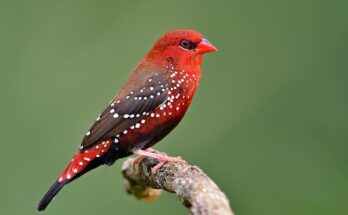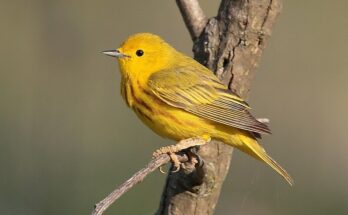Have you ever wondered about the beautiful blue bird that have a splash of red or orange Chest on them? These vibrant birds not only catch our eye with their stunning colors but also play a crucial role in our ecosystem. In this article, we will explore some of these amazing birds: the Belted Kingfisher, Barn Swallow, Red-breasted Nuthatch, Western Bluebird, Eastern Bluebird, and Lazuli Bunting. We’ll dive into their characteristics, from size and diet to interesting habits, making it easy to understand and appreciate these wonderful creatures. Let’s take a closer look at each one!
1. Belted Kingfisher (Megaceryle alcyon)
- Scientific Name: Megaceryle alcyon
- Size: 11-14 inches
- Weight: 4-6 ounces
- Lifespan: Up to 11 years
- Diet: Fish, insects, amphibians, and small crustaceans
The Belted Kingfisher is a striking bird with a bright blue-gray body and a distinctive shaggy crest on its head. Its most notable feature is the orange or rust-colored band across its chest, which is more prominent in females—a rare trait where the female is more colorful than the male.
These birds are often seen near bodies of water, like rivers, lakes, and coastal regions, where they hunt for fish by diving headfirst into the water. The Belted Kingfisher’s loud, rattling call is hard to miss, making it a familiar sound near water bodies. They are skilled hunters and can hover over the water to spot their prey before plunging down for a catch.
2. Barn Swallow (Hirundo rustica)
- Scientific Name: Hirundo rustica
- Size: 5.9-7.5 inches
- Weight: 0.6-0.7 ounces
- Lifespan: 4 years on average
- Diet: Insects, including flies, beetles, and moths
The Barn Swallow is one of the most widespread birds in the world and is easily recognizable by its glossy blue upperparts and cinnamon-red throat and forehead. Its deeply forked tail and agile flight make it a remarkable aerial acrobat.
These birds are often found in open areas such as fields, meadows, and near water, where they catch insects mid-air. Barn Swallows build their cup-shaped mud nests on man-made structures like barns, bridges, and under the eaves of houses, which has led to their common name. They are highly social birds and can often be seen in large flocks, especially during migration.
3. Red-breasted Nuthatch (Sitta canadensis)
- Scientific Name: Sitta canadensis
- Size: 4.3 inches
- Weight: 0.3-0.4 ounces
- Lifespan: Up to 7 years
- Diet: Insects, seeds, nuts, and suet
The Red-breasted Nuthatch is a small, lively bird known for its blue-gray upperparts and rusty-red underparts. These birds are often found in coniferous forests across North America, where they are known for their unique ability to climb down tree trunks headfirst.
This bird’s call is a distinct, nasal “yank-yank,” which can be heard echoing through the forest. The Red-breasted Nuthatch is also known for its bold behavior around feeders, often chasing off larger birds to get its share of seeds and suet. These birds store food for the winter, hiding seeds in tree bark or crevices.
Read More: 5 Types of Hummingbirds in Maryland
4. Western Bluebird (Sialia mexicana)
- Scientific Name: Sialia mexicana
- Size: 6-7 inches
- Weight: 0.9-1.1 ounces
- Lifespan: 6-10 years
- Diet: Insects, fruits, and berries
The Western Bluebird is a stunning bird with a brilliant blue body and a rusty-orange chest. Found primarily in the western United States, this bird prefers open woodlands, farmlands, and even urban parks. Western Bluebirds are cavity nesters, often using old woodpecker holes or nest boxes.
During the breeding season, males can be seen fluttering in front of a potential nest site, showing off their bright colors to attract a mate. These birds are also social and can be seen in small flocks outside the breeding season, often perched on fences or low branches while searching for insects on the ground.
5. Eastern Bluebird (Sialia sialis)
- Scientific Name: Sialia sialis
- Size: 6.3-8.3 inches
- Weight: 1-1.2 ounces
- Lifespan: 6-10 years
- Diet: Insects and berries
The Eastern Bluebird is a beautiful bird with a bright blue back and a warm orange chest, which contrasts nicely with its white belly. This bird is a symbol of happiness and is beloved by many birdwatchers and gardeners for its cheerful song and vibrant colors.
The Eastern Bluebird is found in open habitats, including gardens, orchards, and farmlands, where it feeds mainly on insects during the warmer months and switches to fruits and berries in the winter. These birds are cavity nesters and readily use nest boxes, which has helped them make a strong comeback after population declines in the past.
6. Lazuli Bunting (Passerina amoena)
- Scientific Name: Passerina amoena
- Size: 5-6 inches
- Weight: 0.5 ounces
- Lifespan: 5-7 years
- Diet: Seeds, insects, and berries
The Lazuli Bunting is a striking bird named after the vibrant blue gemstone, lapis lazuli, because of its brilliant blue head and back. Males are particularly eye-catching with their bright blue plumage, rusty-orange chest, and white belly, while females are more muted with brown and light blue shades.
These birds can be found in the western parts of North America, especially in brushy areas, open woodlands, and near streams. During the breeding season, males sing from exposed perches to establish their territory and attract mates. Lazuli Buntings are also known for their migration, traveling long distances between their breeding and wintering grounds.



